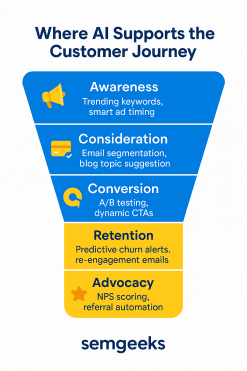Every customer takes a journey before they make a purchasing decision. During this journey, each customer moves through specific stages that include gaining awareness, considering the key points, and making the final purchase. AI and analytics can help you understand what customers are doing at each stage and what you can do to respond better. Here, we’ll explore how to use those tools to improve your company’s SEO, PPC, and email marketing strategies.
Understand the Customer Journey Stages
Taking a quick look at the key stages customers encounter along their journey helps you know where AI and analytics data can help each one.
•Awareness – The customer first hears about your company’s products and services.
•Consideration – They begin searching and making comparisons.
•Conversion – The customer makes a purchase or becomes a lead.
•Retention – Your company’s stellar responses keep them coming back.
•Advocacy – The customer makes referrals to others.
How AI + Analytics Help at Each Stage
Now, let’s see how we can use AI and data analytics to influence results at each stage of the customer journey.
Awareness (Top of the Funnel
In this first stage, we want to get your company’s information in front of the right people by using SEO, PPC, and social media.
How AI helps:
•Locate trending keywords for blog posts
•Suggest ideal times to run ads
•Test ad headlines automatically
Tools: Google Ads, SEMrush, AI writing tools
Consideration (Mid-Funnel)
Here, we’ll educate the customer and build trust with helpful content and follow-up emails.
How AI helps:
•Suggest blog topics based on user behavior
•Segment email lists
•Recommend the content to show next
Tools: Hubspot, chatbots, Mailchimp with AI
Conversion (Bottom of Funnel),
At this point, we are ready to increase ease for customers who are interested in buying or signing up.
How AI helps:
•Tests landing pages and forms
•Shows the best offer or message
•Tracks which ads cover best
Tools: Hotjar, Ad platforms, Google Optimize
Retention
Staying in touch and making customers feel valued increases retention.
How AI helps:
•Sends targeted emails based on past purchasing patterns
•Flags customers who are likely to stop using the products
Tools: CRMs with AI features and email automation platforms
Advocacy
At the final stage, we want to encourage customers to make referrals and leave positive reviews.
How AI helps:
•Identify the happiest customers
•Automate referral offers and rewards
Tools: Referral marketing tools and NPS surveys
Explore Real Examples and Case Studies
Our team tracks our metrics to identify positive outcomes that guide our marketing decisions. In one case study, we chose to focus on implementing a comprehensive SEO strategy for Lanco Adhesives that incorporated analytics and AI to find relevant keywords that made it possible to create relevant, timely content.
As a result of this targeted SEO campaign, we increased organic leads by 76% YoY. Website users further increased by 154% YoY. Our efforts also led to more on-site engagement by raising the metrics by 23% YoY.
Plan How to Start Mapping Your Customer Journey
This step-by-step guide will help you begin mapping your customers’ journeys and implement the right strategies to streamline the buying process.
1. Gather your data: Using information-gathering tools such as Google Analytics, ad platforms, and CRM
2. List key touchpoints: What customers are seeing and doing at each stage
3. Use mapping tools: For example, Miro or Lucidchart to sketch it all out
4. Add AI tools: To enhance personalization, get recommendations, and perform trend analysis.
5. Track and improve: Watch for drop-offs and correct gaps with better content or targeting
Choose Helpful Tools and Metrics to Use
Finding the right tools and metrics that work best for your company gives you an edge on the competition for creating effective marketing strategies, and these are a few of our favorites.
Effective Tools
•Hotjar
•Google Analytics 4
•Hubspot
•SEMrush or Ahrefs for SEO
•Meta, Google Ads with AI bidding, and other ad platforms
Key Metrics to Track
•Traffic and impressions (awareness stage)
•Time on site and email opens (consideration stage)
•Conversions and CPA (conversion stage)
•Repeat purchases and churn rate (retention stage)
•NPS and referrals (advocacy stage)
Avoid These Common Mistakes
As you begin using AI to map the customer journey, make sure to avoid these mistakes that could impact the effectiveness of your strategies.
•Avoid relying on old data — plan frequent updates
•Avoid keeping your data in silos — focus on integration
•Avoid ignoring small signals — sometimes small drop-offs indicate bigger problems
•Avoid adding tools without a defined strategy — start simple and scale up
Final Thoughts: Think Long-Term
AI and analytics aren’t just convenient tools that are nice to have. Instead, they are how modern businesses grow smarter. When we use them correctly, they can turn guesswork into an effective strategy.
Want help mapping your journey? Our team can audit your current setup and recommend the right AI tools and next steps to take your company to the next level.


